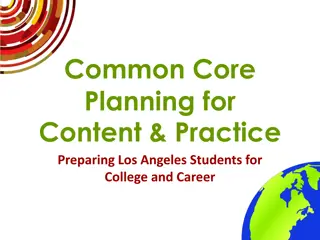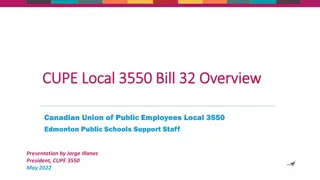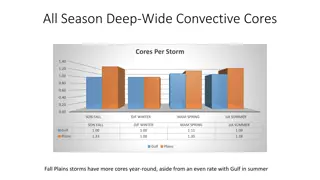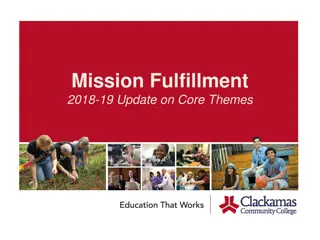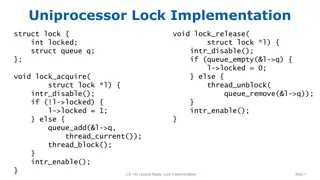
Braille Aligned Grade-Level Standards for Common Core Subjects
Explore how braille standards are aligned to the Common Core Prekindergarten through grade 12 English/Language Arts and Mathematics. Discover resources, checklists, and assessments for aligning IEP goals with content standards.
Download Presentation

Please find below an Image/Link to download the presentation.
The content on the website is provided AS IS for your information and personal use only. It may not be sold, licensed, or shared on other websites without obtaining consent from the author. If you encounter any issues during the download, it is possible that the publisher has removed the file from their server.
You are allowed to download the files provided on this website for personal or commercial use, subject to the condition that they are used lawfully. All files are the property of their respective owners.
The content on the website is provided AS IS for your information and personal use only. It may not be sold, licensed, or shared on other websites without obtaining consent from the author.
E N D
Presentation Transcript
Grade level standards for braille aligned to the Common Core Prekindergarten through grade 12 English/Language Arts Literary Braille Readiness: Hand movements, use of braille writer Alphabet Contractions Textbook formats Mathematics Nemeth Code Tactile graphics 2
Aligned to the Common Core, can be used by any State Identify grade level standards for areas not previously aligned Formats Nemeth Tactile graphics Includes standards, checklists, and resource list Can be used for formative assessments and IEP goals 3
Do YOU need to align your IEP Goals and Objectives for Braille to content standards? 4
MD has PreK standards that are not part of Common Core MD did not add any other additional unique standards Only grade-level standards for braille, not instructional strategies for teaching braille It does not include any other skills beside braille 5
Introduction, References Standards ELA by strands Math by grades Appendix A ELA: Literacy Braille code and Formatting Mathematics: Nemeth Braille code and tactile graphics Appendix B: Acronyms and Definitions Appendix C: Resources Appendix D: Instructional Materials Appendix E: ELA: Tactile Editing Marks 6
http://mdk12.org/instruction/commoncore/braille/ind ex.html 8
Range of Reading Informational Text - biographies, speeches, letters, newspaper articles Functional text: forms, procedures, directions, and information displayed in graphs, charts, or maps Complexity of Reading word/sentence/passage length, higher levels of meaning/ purpose, and higher vocabulary/language and knowledge demands Reading fluency reading text with speed, accuracy, and proper expression. 9
Knowledge of all literary contractions by the end of grade 2 Knowledge of all punctuation and braille signs of composition by the end of grade 3 Knowledge of some computer braille code (websites, email addresses) Grade level reading skills: vocabulary, fluency, comprehension, reading speed Access to text and multimedia Common Core Standards Appendix B Text Exemplars: http://www.corestandards.org/assets/Appendix_B.pdf 10
Print features table of contents, index, glossary, appendix, pronunciation guide Organizational aids bold/colored print, italics, bullets, titles, headings, subheadings, captions, labels, sidebars Graphic aids diagrams, graphs, figures, maps, charts/tables, timelines Illustrations photographs, drawings 11
Need to know Braille Formats http://www.brailleauthority.org/formats/2011manual- web/index.html Need to know Guidelines and Standards for Tactile Graphics (2010) diagrams, maps, graphs, tables, timelines http://www.brailleauthority.org/tg/web- manual/index.html 12
Primarily nonfiction: argument, opinion, informative/explanatory Research (Grade 6 bibliography) Cite evidence, analyze content, record and analyze data Prepare product for publication/presentation Integration of technology 13
Keyboarding skills type pages within a single sitting Grade 4: 1 page, Grade 5: 2 pages, Grade 6: 3 pages Presentation software, word processing, and spreadsheets Mainstream devices (iPad, laptop/desktop) Collaboration and shared writing Digital Texts Internet skills Web navigation Contribute to a learning community Using online resources Accessible web tools 14
What do YOU need to learn more about to ensure braille readers meet grade level English/Language Arts standards? 15
Narrow scope and deepen understanding Procedural skill and fluency quickly and accurately Application: to real world and apply skills Rigor of skills 16
Learn Nemeth Code numerals and symbols beginning in Prekindergarten New Nemeth Code introduced at every grade level through high school Emphasis on reading and creating Tactile Graphics 17
Pre-K through grade 5 focus is computation of whole numbers, fractions, and decimals. Measurement and geometry tied to numbers and operations Middle school ratio, proportions, statistics, algebra, foundations of geometry High School functions, statistics, geometry, algebra 18
http://mdk12.org/instruction/commoncore/braille/ind ex.html 20
Expectations for participation by all in higher level mathematics (Algebra 1 and 2 and Geometry) Strong knowledge of Nemeth Code Strong skills in reading tactile graphics Guidelines and Standards for Tactile Graphics (2010) diagrams, maps, graphs, tables, timelines http://www.brailleauthority.org/tg/web- manual/index.html 21
http://mdk12.org/instruction/commoncore/braille/ind ex.html 23
What do YOU need to learn more about to ensure braille readers meet grade level Mathematics? 24
Same content. High expectations. Identified needed braille skills. 25




